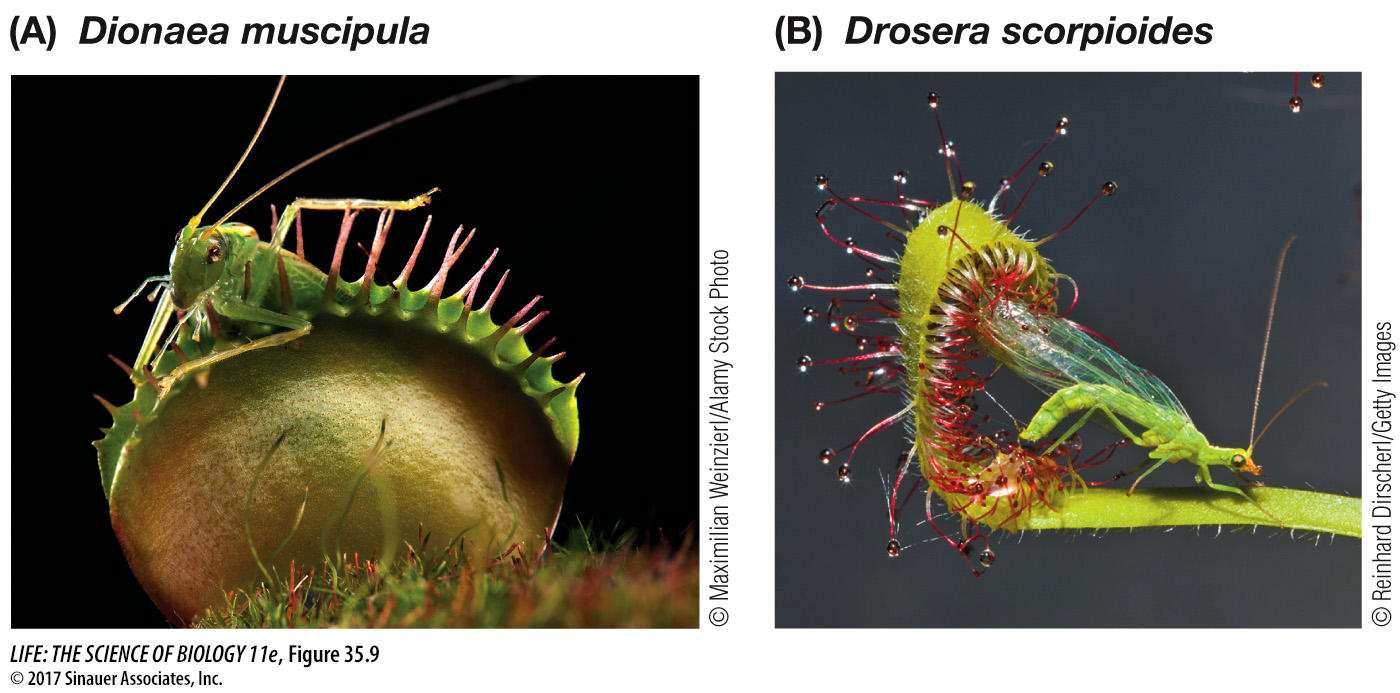Carnivorous plants supplement their mineral nutrition
Some plants augment their nitrogen supply by capturing and digesting flies and other insects. There are about 500 of these carnivorous plant species, the best known of which are Venus flytraps (genus Dionaea) (Figure 35.9A), sundews (genus Drosera) (Figure 35.9B), and pitcher plants (genus Sarracenia).

Figure 35.9 Carnivorous Plants Some plants have adapted to nitrogen-poor environments by becoming carnivorous. (A) The Venus flytrap obtains nitrogen from the bodies of insects trapped inside the plant when its hinges snap shut. (B) Sundews trap insects on sticky hairs. Secreted enzymes will digest the carcass externally.
Media Clip 35.1 A Venus Flytrap “Snaps to It”
Carnivorous plants are typically found in boggy habitats that are acidic and nutrient-deficient. To obtain extra nitrogen, these plants capture animals, digest their proteins, and absorb the amino acids. Pitcher plants have pitcher-shaped leaves that collect small amounts of rainwater. Insects and even small rodents are lured into the pitchers by bright colors or attractive scents and are prevented from leaving by stiff, downward-pointing hairs. The animals eventually die and are digested by a combination of plant enzymes and bacteria in the water. Sundews have leaves covered with hairs that secrete a sticky, sugary liquid. Insects become stuck to these hairs, and more hairs curve over to further entrap them. Enzymes secreted by the plant digest the insects. Venus flytraps have specialized leaves with two halves that fold together. When an insect touches special hairs called trigger hairs on the leaf, its two halves snap together. The spiny margins interlock and imprison the insect before it can escape. The leaf then secretes enzymes that digest its prey.
The closing of the Venus flytrap’s leaf is one of the fastest movements in the plant world, requiring only 0.1 seconds. To find out how this happens, Dr. Lakshminarayanan Mahadevan and colleagues at Harvard University painted fluorescent dots on the surface of the flytrap’s leaf surface and used high-speed cameras to record the trap snapping shut when its trigger hairs were touched. They then used computer analysis of the recorded dot movements to generate a mathematical model to help explain the movement. The researchers found that the first step is the osmosis-driven elongation of cells on the outer surface of the leaf. The expansion of only one side of the leaf causes it to snap from a convex into a concave shape, much like a contact lens flipping inside out.
Carnivorous plants photosynthesize and extract soil nutrients just like other plants, but eating insects helps them grow faster in their natural habitats. They use the additional nitrogen from the insects to make more proteins, chlorophyll, and other nitrogen-containing compounds.
